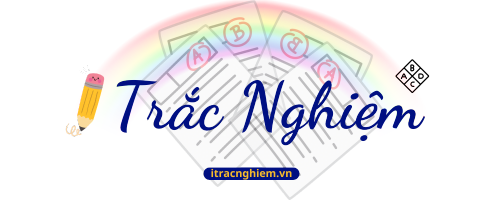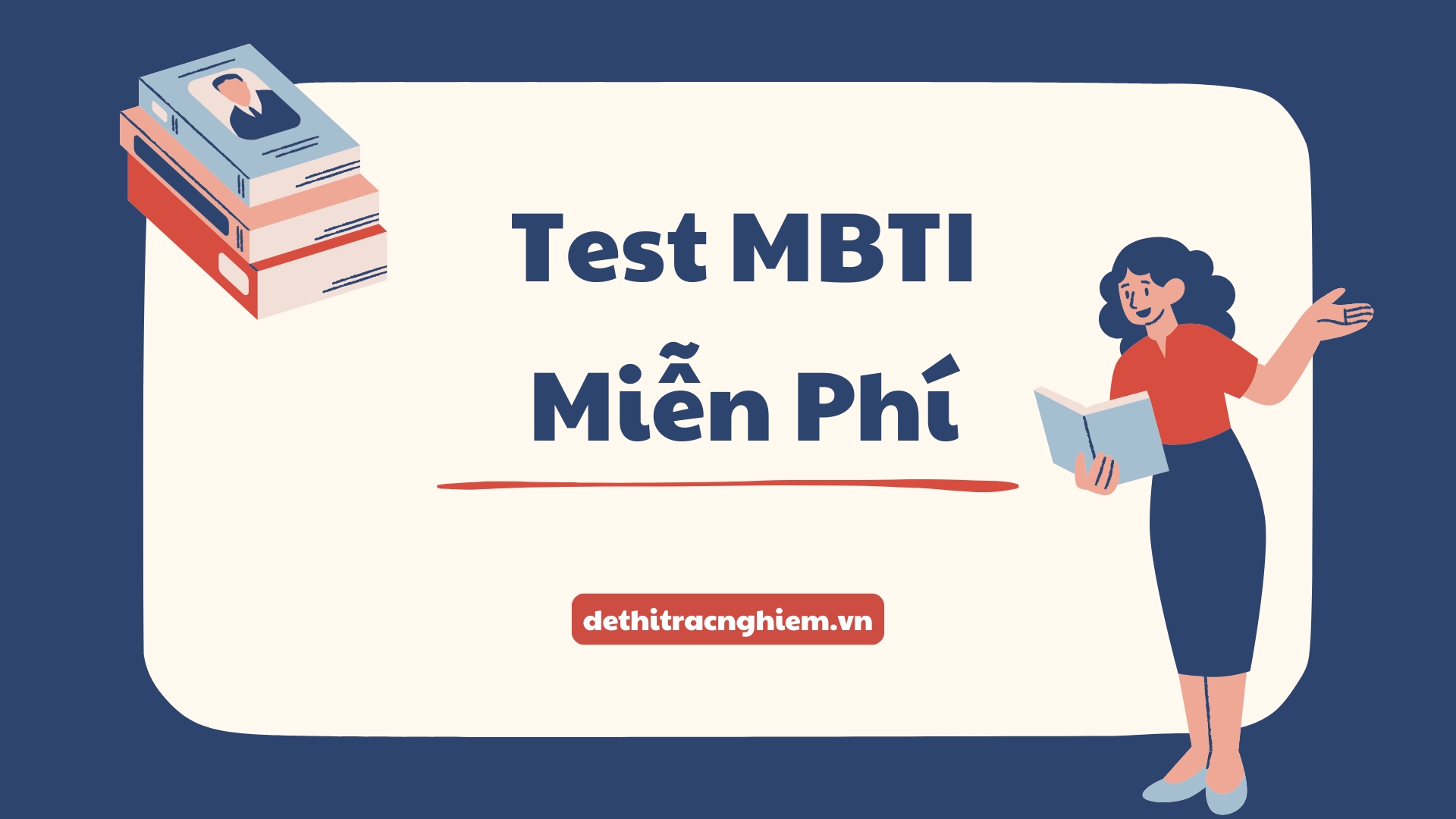Đề thi thử Đại học 2025 môn Tiếng Anh – Sở GD&ĐT Vĩnh Phúc (Mã đề 904) là một trong những đề tiêu biểu thuộc Tổng hợp đề thi thử môn Tiếng Anh THPT QG, nằm trong chương trình Đề thi vào Đại học. Đây là đề thi chính thức do Sở Giáo dục và Đào tạo tỉnh Vĩnh Phúc tổ chức, có mã đề 904, được biên soạn bám sát theo cấu trúc và định hướng ra đề của Bộ GD&ĐT cho kỳ thi tốt nghiệp THPT năm 2025.
Đề thi bao gồm đầy đủ các phần kỹ năng: ngữ âm (phát âm – trọng âm), ngữ pháp – từ vựng, chức năng giao tiếp, đọc hiểu hai đoạn văn học thuật, điền từ vào đoạn văn (cloze test), và viết lại câu (sentence transformation). Với cấu trúc đề phân hóa tốt, kết hợp giữa kiến thức cơ bản và nâng cao, đề thi giúp học sinh không chỉ ôn tập toàn diện mà còn luyện được kỹ năng làm bài nhanh, chính xác, đáp ứng yêu cầu cả về kiến thức lẫn thời gian.
Hãy cùng Dethitracnghiem.vn khám phá đề thi thử mã đề 904 này và bắt đầu luyện tập để tự tin bước vào kỳ thi THPT Quốc gia 2025 với phong độ tốt nhất!
- Số trang: 4 trang
- Hình thức: Trắc nghiệm
- Thời gian làm bài: 50 phút (không kể thời gian phát đề)
ĐỀ THI THỬ ĐẠI HỌC MÔN TIẾNG ANH NĂM 2025 SỞ GD&ĐT VĨNH PHÚC ( MÃ ĐỀ 904)
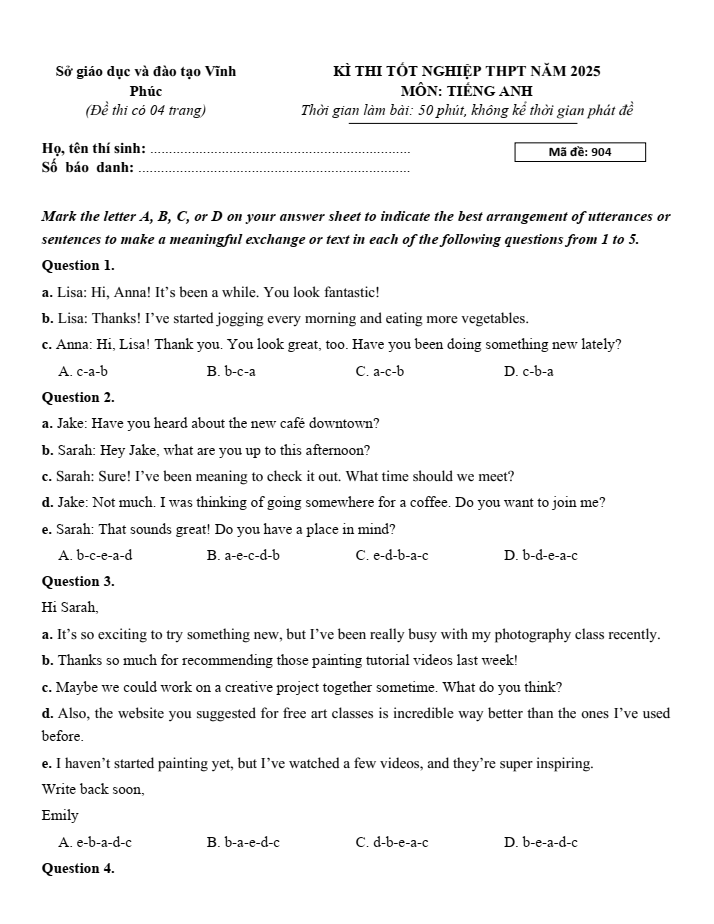
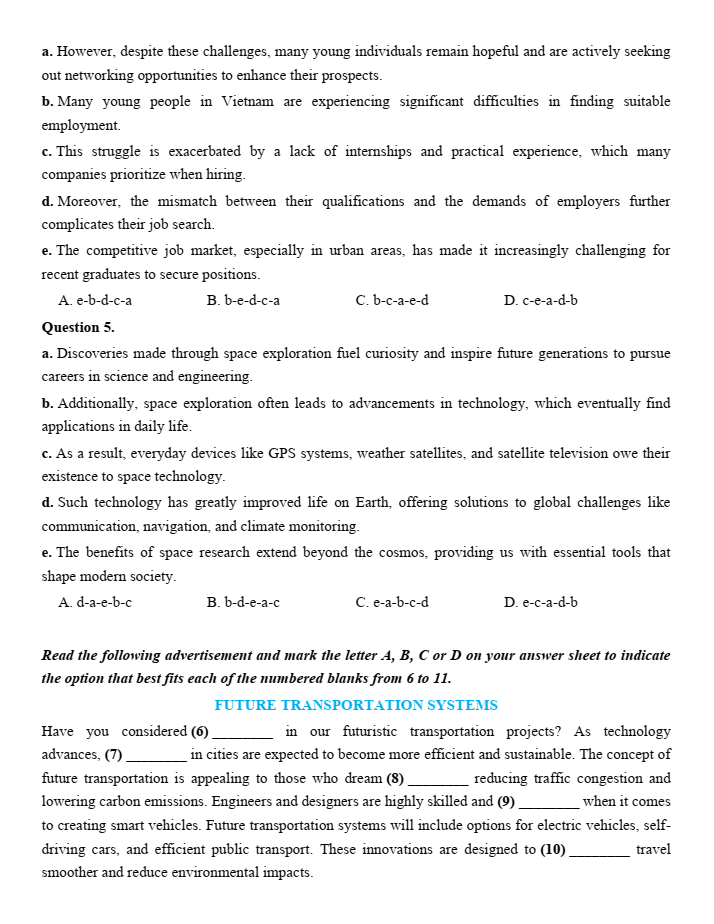
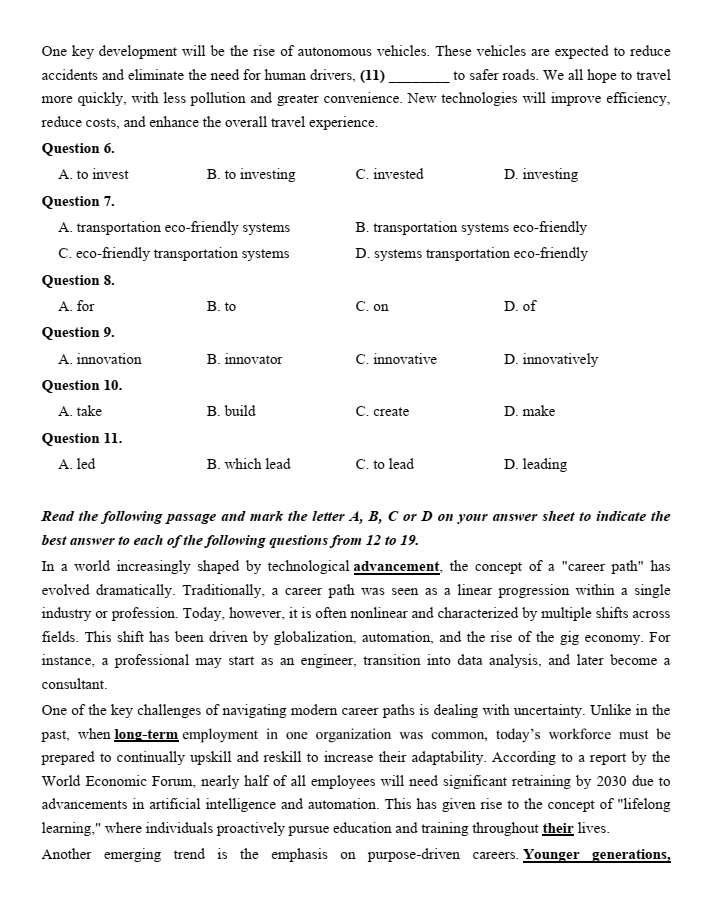
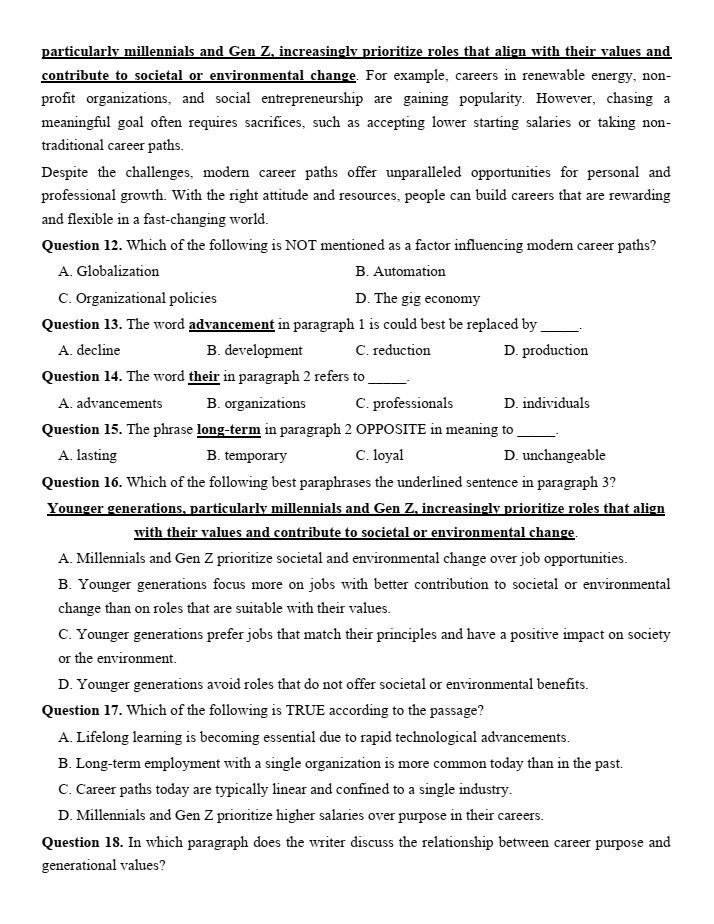
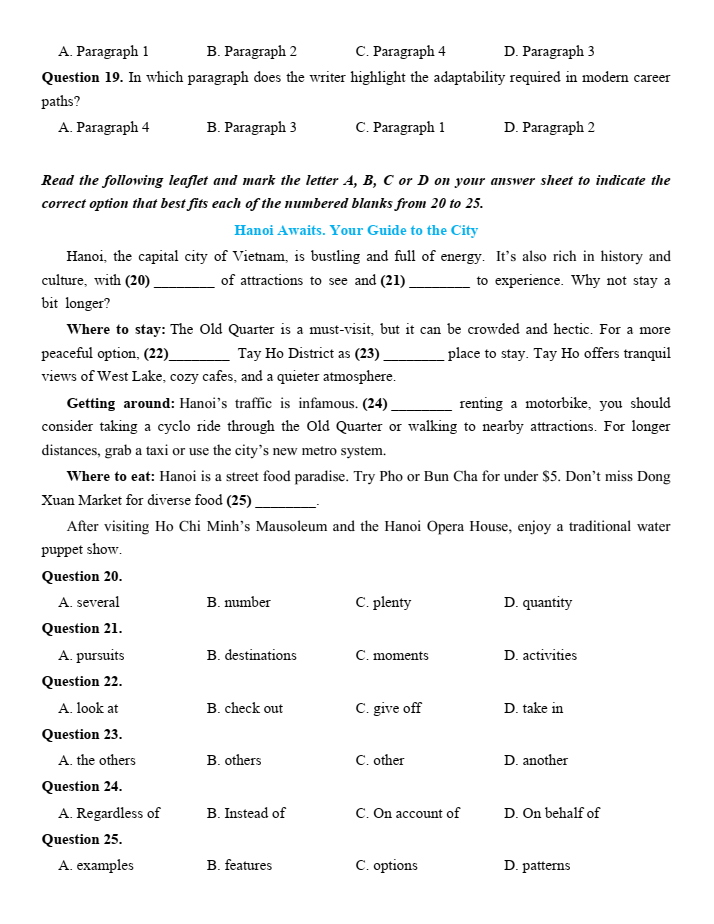
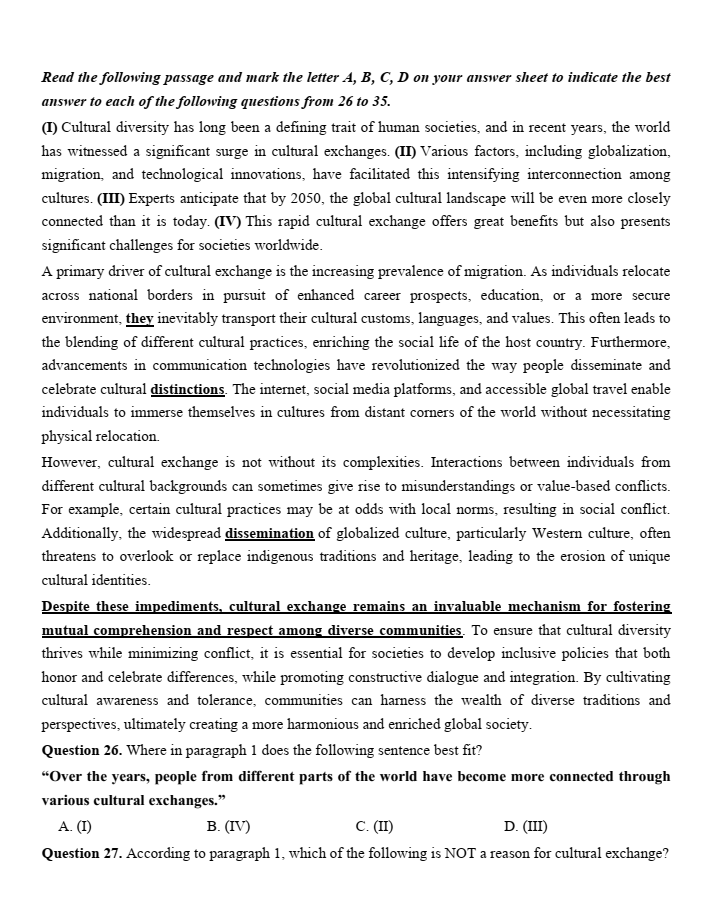
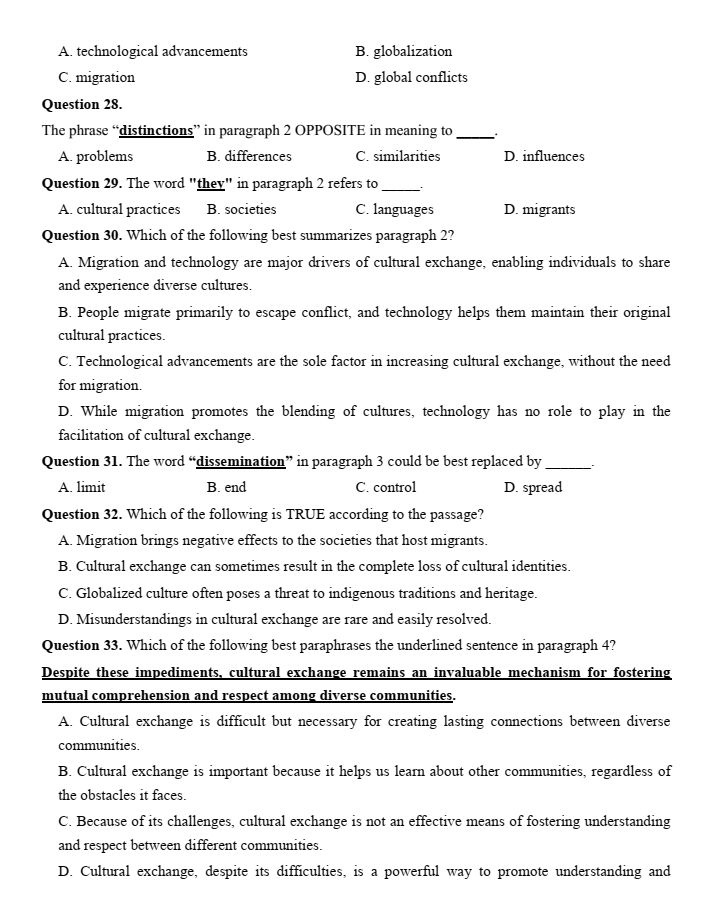
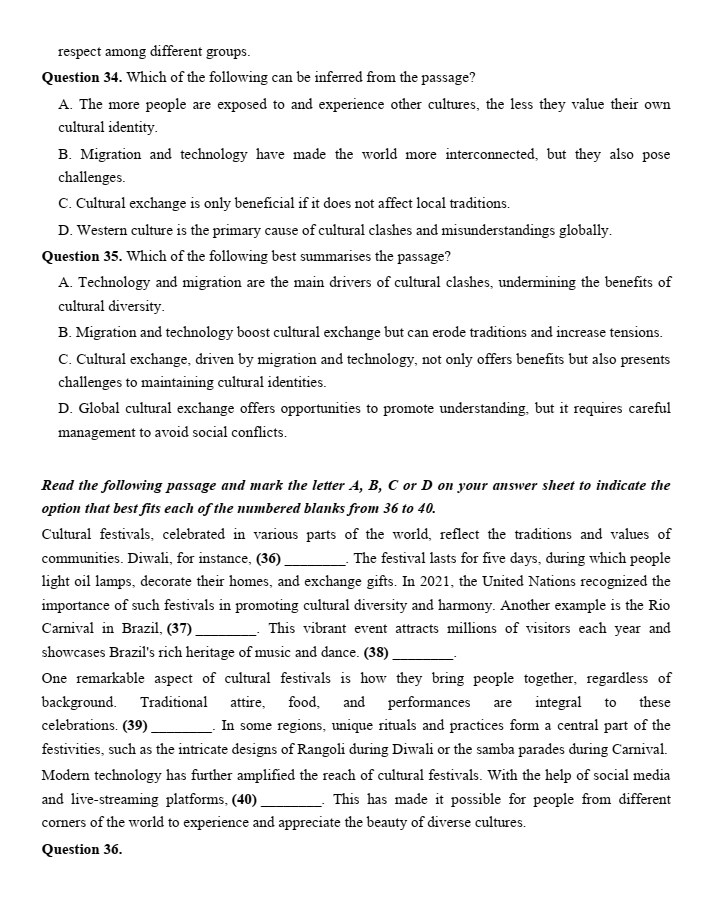
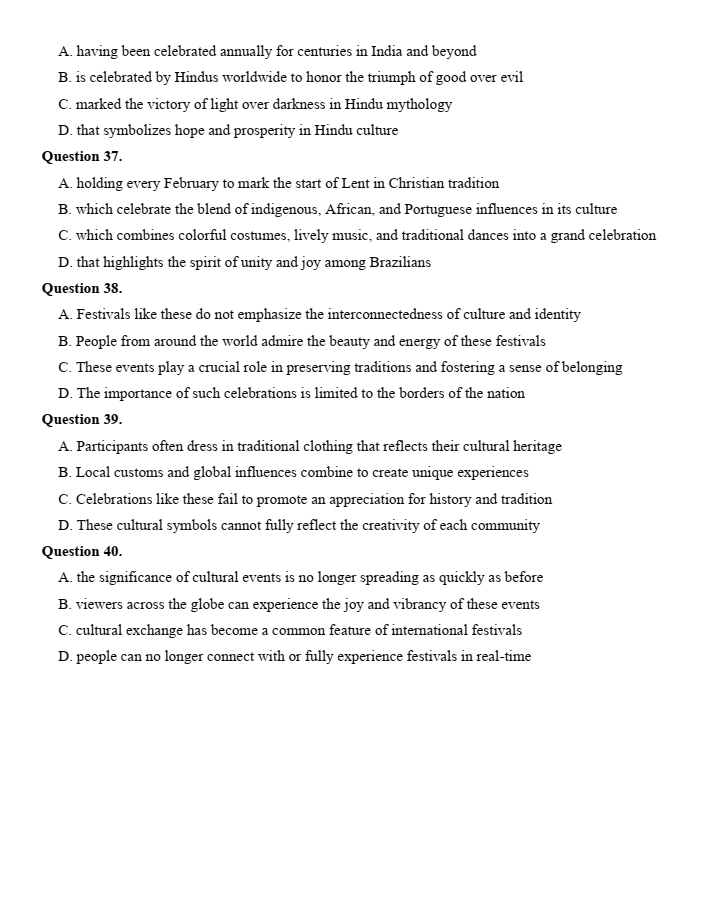
Mark the letter A, B, C, or D on your answer sheet to indicate the best arrangement of utterances or sentences to make a meaningful exchange or text in each of the following questions from 1 to 5.
Question 1.
a. Lisa: Hi, Anna! It’s been a while. You look fantastic!
b. Lisa: Thanks! I’ve started jogging every morning and eating more vegetables.
c. Anna: Hi, Lisa! Thank you. You look great, too. Have you been doing something new lately?
A. c-a-b
B. b-c-a
C. a-c-b
D. c-b-a
Question 2.
a. Jake: Have you heard about the new café downtown?
b. Sarah: Hey Jake, what are you up to this afternoon?
c. Sarah: Sure! I’ve been meaning to check it out. What time should we meet?
d. Jake: Not much. I was thinking of going somewhere for a coffee. Do you want to join me?
e. Sarah: That sounds great! Do you have a place in mind?
A. b-c-e-a-d
B. a-e-c-d-b
C. e-d-b-a-c
D. b-d-e-a-c
Question 3.
Hi Sarah,
a. It’s so exciting to try something new, but I’ve been really busy with my photography class recently.
b. Thanks so much for recommending those painting tutorial videos last week!
c. Maybe we could work on a creative project together sometime. What do you think?
d. Also, the website you suggested for free art classes is incredible way better than the ones I’ve used before.
e. I haven’t started painting yet, but I’ve watched a few videos, and they’re super inspiring.
Write back soon,
Emily
A. e-b-a-d-c
B. b-a-e-d-c
C. d-b-e-a-c
D. b-e-a-d-c
Question 4.
a. However, despite these challenges, many young individuals remain hopeful and are actively seeking out networking opportunities to enhance their prospects.
b. Many young people in Vietnam are experiencing significant difficulties in finding suitable employment.
c. This struggle is exacerbated by a lack of internships and practical experience, which many companies prioritize when hiring.
d. Moreover, the mismatch between their qualifications and the demands of employers further complicates their job search.
e. The competitive job market, especially in urban areas, has made it increasingly challenging for recent graduates to secure positions.
A. e-b-d-c-a
B. b-e-d-c-a
C. b-c-a-e-d
D. c-e-a-d-b
Question 5.
a. Discoveries made through space exploration fuel curiosity and inspire future generations to pursue careers in science and engineering.
b. Additionally, space exploration often leads to advancements in technology, which eventually find applications in daily life.
c. As a result, everyday devices like GPS systems, weather satellites, and satellite television owe their existence to space technology.
d. Such technology has greatly improved life on Earth, offering solutions to global challenges like communication, navigation, and climate monitoring.
e. The benefits of space research extend beyond the cosmos, providing us with essential tools that shape modern society.
A. d-a-e-b-c
B. b-d-e-a-c
C. e-a-b-c-d
D. e-c-a-d-b
Read the following advertisement and mark the letter A, B, C or D on your answer sheet to indicate the option that best fits each of the numbered blanks from 6 to 11.
FUTURE TRANSPORTATION SYSTEMS
Have you considered (6)______ in our futuristic transportation projects? As technology advances, (7)______ in cities are expected to become more efficient and sustainable. The concept of future transportation is appealing to those who dream (8)______ reducing traffic congestion and lowering carbon emissions. Engineers and designers are highly skilled and (9)______ when it comes to creating smart vehicles. Future transportation systems will include options for electric vehicles, self-driving cars, and efficient public transport. These innovations are designed to (10)______ travel smoother and reduce environmental impacts.
One key development will be the rise of autonomous vehicles. These vehicles are expected to reduce accidents and eliminate the need for human drivers, (11)______ to safer roads. We all hope to travel more quickly, with less pollution and greater convenience. New technologies will improve efficiency, reduce costs, and enhance the overall travel experience.
Question 6.
A. to invest
B. to investing
C. invested
D. investing
Question 7.
A. transportation eco-friendly systems
B. transportation systems eco-friendly
C. eco-friendly transportation systems
D. systems transportation eco-friendly
Question 8.
A. for
B. to
C. on
D. of
Question 9.
A. innovation
B. innovator
C. innovative
D. innovatively
Question 10.
A. take
B. build
C. create
D. make
Question 11.
A. led
B. which lead
C. to lead
D. leading
Read the following passage and mark the letter A, B, C or D on your answer sheet to indicate the best answer to each of the following questions from 12 to 19.
In a world increasingly shaped by technological **advancement**, the concept of a “career path” has evolved dramatically. Traditionally, a career path was seen as a linear progression within a single industry or profession. Today, however, it is often nonlinear and characterized by multiple shifts across fields. This shift has been driven by globalization, automation, and the rise of the gig economy. For instance, a professional may start as an engineer, transition into data analysis, and later become a consultant.
One of the key challenges of navigating modern career paths is dealing with uncertainty. Unlike in the past, when **long-term** employment in one organization was common, today’s workforce must be prepared to continually upskill and reskill to increase their adaptability. According to a report by the World Economic Forum, nearly half of all employees will need significant retraining by 2030 due to advancements in artificial intelligence and automation. This has given rise to the concept of “lifelong learning,” where individuals proactively pursue education and training throughout **their** lives.
Another emerging trend is the emphasis on purpose-driven careers. **Younger generations, particularly millennials and Gen Z, increasingly prioritize roles that align with their values and contribute to societal or environmental change.** For example, careers in renewable energy, non-profit organizations, and social entrepreneurship are gaining popularity. However, chasing a meaningful goal often requires sacrifices, such as accepting lower starting salaries or taking non-traditional career paths.
Despite the challenges, modern career paths offer unparalleled opportunities for personal and professional growth. With the right attitude and resources, people can build careers that are rewarding and flexible in a fast-changing world.
Question 12. Which of the following is NOT mentioned as a factor influencing modern career paths?
A. Globalization
B. Automation
C. Organizational policies
D. The gig economy
Question 13. The word **advancement** in paragraph 1 is could best be replaced by ______.
A. decline
B. development
C. reduction
D. production
Question 14. The word **their** in paragraph 2 refers to ______.
A. advancements
B. organizations
C. professionals
D. individuals
Question 15. The phrase **long-term** in paragraph 2 OPPOSITE in meaning to ______.
A. lasting
B. temporary
C. loyal
D. unchangeable
Question 16. Which of the following best paraphrases the underlined sentence in paragraph 3?
Younger generations, particularly millennials and Gen Z, increasingly prioritize roles that align with their values and contribute to societal or environmental change.
A. Millennials and Gen Z prioritize societal and environmental change over job opportunities.
B. Younger generations focus more on jobs with better contribution to societal or environmental change than on roles that are suitable with their values.
C. Younger generations prefer jobs that match their principles and have a positive impact on society or the environment.
D. Younger generations avoid roles that do not offer societal or environmental benefits.
Question 17. Which of the following is TRUE according to the passage?
A. Lifelong learning is becoming essential due to rapid technological advancements.
B. Long-term employment with a single organization is more common today than in the past.
C. Career paths today are typically linear and confined to a single industry.
D. Millennials and Gen Z prioritize higher salaries over purpose in their careers.
Question 18. In which paragraph does the writer discuss the relationship between career purpose and generational values?
A. Paragraph 1
B. Paragraph 2
C. Paragraph 4
D. Paragraph 3
Question 19. In which paragraph does the writer highlight the adaptability required in modern career paths?
A. Paragraph 4
B. Paragraph 3
C. Paragraph 1
D. Paragraph 2
Read the following leaflet and mark the letter A, B, C or D on your answer sheet to indicate the correct option that best fits each of the numbered blanks from 20 to 25.
Hanoi Awaits: Your Guide to the City
Hanoi, the capital city of Vietnam, is bustling and full of energy. It’s also rich in history and culture, with (20)______ of attractions to see and (21)______ to experience. Why not stay a bit longer?
Where to stay: The Old Quarter is a must-visit, but it can be crowded and hectic. For a more peaceful option, (22)______ Tay Ho District as (23)______ place to stay. Tay Ho offers tranquil views of West Lake, cozy cafes, and a quieter atmosphere.
Getting around: Hanoi’s traffic is infamous. (24)______ renting a motorbike, you should consider taking a cyclo ride through the Old Quarter or walking to nearby attractions. For longer distances, grab a taxi or use the city’s new metro system.
Where to eat: Hanoi is a street food paradise. Try Pho or Bun Cha for under $5. Don’t miss Dong Xuan Market for diverse food (25)______.
After visiting Ho Chi Minh’s Mausoleum and the Hanoi Opera House, enjoy a traditional water puppet show.
Question 20.
A. several
B. number
C. plenty
D. quantity
Question 21.
A. pursuits
B. destinations
C. moments
D. activities
Question 22.
A. look at
B. check out
C. give off
D. take in
Question 23.
A. the others
B. others
C. other
D. another
Question 24.
A. Regardless of
B. Instead of
C. On account of
D. On behalf of
Question 25.
A. examples
B. features
C. options
D. patterns
Read the following passage and mark the letter A, B, C, D on your answer sheet to indicate the best answer to each of the following questions from 26 to 35.
(I) Cultural diversity has long been a defining trait of human societies, and in recent years, the world has witnessed a significant surge in cultural exchanges. (II) Various factors, including globalization, migration, and technological innovations, have facilitated this intensifying interconnection among cultures. (III) Experts anticipate that by 2050, the global cultural landscape will be even more closely connected than it is today. (IV) This rapid cultural exchange offers great benefits but also presents significant challenges for societies worldwide.
A primary driver of cultural exchange is the increasing prevalence of migration. As individuals relocate across national borders in pursuit of enhanced career prospects, education, or a more secure environment, **they** inevitably transport their cultural customs, languages, and values. This often leads to the blending of different cultural practices, enriching the social life of the host country. Furthermore, advancements in communication technologies have revolutionized the way people disseminate and celebrate cultural **distinctions**. The internet, social media platforms, and accessible global travel enable individuals to immerse themselves in cultures from distant corners of the world without necessitating physical relocation.
However, cultural exchange is not without its complexities. Interactions between individuals from different cultural backgrounds can sometimes give rise to misunderstandings or value-based conflicts. For example, certain cultural practices may be at odds with local norms, resulting in social conflict. Additionally, the widespread **dissemination** of globalized culture, particularly Western culture, often threatens to overlook or replace indigenous traditions and heritage, leading to the erosion of unique cultural identities.
**Despite these impediments, cultural exchange remains an invaluable mechanism for fostering mutual comprehension and respect among diverse communities.** To ensure that cultural diversity thrives while minimizing conflict, it is essential for societies to develop inclusive policies that both honor and celebrate differences, while promoting constructive dialogue and integration. By cultivating cultural awareness and tolerance, communities can harness the wealth of diverse traditions and perspectives, ultimately creating a more harmonious and enriched global society.
Question 26. Where in paragraph 1 does the following sentence best fit?
“Over the years, people from different parts of the world have become more connected through various cultural exchanges.”
A. (I)
B. (IV)
C. (II)
D. (III)
Question 27. According to paragraph 1, which of the following is NOT a reason for cultural exchange?
A. technological advancements
B. globalization
C. migration
D. global conflicts
Question 28. The phrase “**distinctions**” in paragraph 2 OPPOSITE in meaning to ______.
A. problems
B. differences
C. similarities
D. influences
Question 29. The word “**they**” in paragraph 2 refers to ______.
A. cultural practices
B. societies
C. languages
D. migrants
Question 30. Which of the following best summarizes paragraph 2?
A. Migration and technology are major drivers of cultural exchange, enabling individuals to share and experience diverse cultures.
B. People migrate primarily to escape conflict, and technology helps them maintain their original cultural practices.
C. Technological advancements are the sole factor in increasing cultural exchange, without the need for migration.
D. While migration promotes the blending of cultures, technology has no role to play in the facilitation of cultural exchange.
Question 31. The word “**dissemination**” in paragraph 3 could be best replaced by ______.
A. limit
B. end
C. control
D. spread
Question 32. Which of the following is TRUE according to the passage?
A. Migration brings negative effects to the societies that host migrants.
B. Cultural exchange can sometimes result in the complete loss of cultural identities.
C. Globalized culture often poses a threat to indigenous traditions and heritage.
D. Misunderstandings in cultural exchange are rare and easily resolved.
Question 33. Which of the following best paraphrases the underlined sentence in paragraph 4?
Despite these impediments, cultural exchange remains an invaluable mechanism for fostering mutual comprehension and respect among diverse communities.
A. Cultural exchange is difficult but necessary for creating lasting connections between diverse communities.
B. Cultural exchange is important because it helps us learn about other communities, regardless of the obstacles it faces.
C. Because of its challenges, cultural exchange is not an effective means of fostering understanding and respect between different communities.
D. Cultural exchange, despite its difficulties, is a powerful way to promote understanding and respect among different groups.
Question 34. Which of the following can be inferred from the passage?
A. The more people are exposed to and experience other cultures, the less they value their own cultural identity.
B. Migration and technology have made the world more interconnected, but they also pose challenges.
C. Cultural exchange is only beneficial if it does not affect local traditions.
D. Western culture is the primary cause of cultural clashes and misunderstandings globally.
Question 35. Which of the following best summarises the passage?
A. Technology and migration are the main drivers of cultural clashes, undermining the benefits of cultural diversity.
B. Migration and technology boost cultural exchange but can erode traditions and increase tensions.
C. Cultural exchange, driven by migration and technology, not only offers benefits but also presents challenges to maintaining cultural identities.
D. Global cultural exchange offers opportunities to promote understanding, but it requires careful management to avoid social conflicts.
Read the following passage and mark the letter A, B C or D on your answer sheet to indicate the option that best fits each of the numbered blanks from 36 to 40.
Cultural festivals, celebrated in various parts of the world, reflect the traditions and values of communities. Diwali, for instance, (36)______. The festival lasts for five days, during which people light oil lamps, decorate their homes, and exchange gifts. In 2021, the United Nations recognized the importance of such festivals in promoting cultural diversity and harmony. Another example is the Rio Carnival in Brazil, (37)______. This vibrant event attracts millions of visitors each year and showcases Brazil’s rich heritage of music and dance (38)______.
One remarkable aspect of cultural festivals is how they bring people together, regardless of background. Traditional attire, food, and performances are integral to these celebrations. (39)______. In some regions, unique rituals and practices form a central part of the festivities, such as the intricate designs of Rangoli during Diwali or the samba parades during Carnival. Modern technology has further amplified the reach of cultural festivals. With the help of social media and live-streaming platforms, (40)______. This has made it possible for people from different corners of the world to experience and appreciate the beauty of diverse cultures.
Question 36.
A. having been celebrated annually for centuries in India and beyond
B. is celebrated by Hindus worldwide to honor the triumph of good over evil
C. marked the victory of light over darkness in Hindu mythology
D. that symbolizes hope and prosperity in Hindu culture
Question 37.
A. holding every February to mark the start of Lent in Christian tradition
B. which celebrate the blend of indigenous, African, and Portuguese influences in its culture
C. which combines colorful costumes, lively music, and traditional dances into a grand celebration
D. that highlights the spirit of unity and joy among Brazilians
Question 38.
A. Festivals like these do not emphasize the interconnectedness of culture and identity
B. People from around the world admire the beauty and energy of these festivals
C. These events play a crucial role in preserving traditions and fostering a sense of belonging
D. The importance of such celebrations is limited to the borders of the nation
Question 39.
A. Participants often dress in traditional clothing that reflects their cultural heritage
B. Local customs and global influences combine to create unique experiences
C. Celebrations like these fail to promote an appreciation for history and tradition
D. These cultural symbols cannot fully reflect the creativity of each community
Question 40.
A. the significance of cultural events is no longer spreading as quickly as before
B. viewers across the globe can experience the joy and vibrancy of these events
C. cultural exchange has become a common feature of international festivals
D. people can no longer connect with or fully experience festivals in real-time
Mục đích tổ chức kỳ thi Đại học năm 2025 là gì?
Căn cứ theo quy chế hiện hành của Bộ Giáo dục và Đào tạo và các văn bản hướng dẫn tổ chức kỳ thi Đại học năm 2025, mục đích của kỳ thi là:
– Đánh giá kết quả học tập của học sinh sau 12 năm học theo yêu cầu của chương trình giáo dục phổ thông.
– Lấy kết quả thi để xét công nhận tốt nghiệp trung học phổ thông và làm căn cứ tuyển sinh đại học, cao đẳng.
– Góp phần đánh giá chất lượng giáo dục của địa phương và cả nước, làm cơ sở điều chỉnh nội dung, phương pháp dạy học trong nhà trường.
Thí sinh thi Đại học năm 2025 có bắt buộc thi môn Tiếng Anh không?
Theo quy định hiện hành của Bộ Giáo dục và Đào tạo và hướng dẫn tổ chức kỳ thi tốt nghiệp Đại học năm 2025, thí sinh dự thi phải thực hiện như sau:
– Thi 3 môn bắt buộc: Toán, Ngữ văn và Ngoại ngữ.
– Ngoài ra, thí sinh phải chọn một trong hai bài thi tổ hợp: Khoa học Tự nhiên (gồm các môn Vật lí, Hóa học, Sinh học) hoặc Khoa học Xã hội (gồm các môn Lịch sử, Địa lí, Giáo dục công dân – dành cho học sinh học chương trình giáo dục phổ thông).
Trong số các môn thi, Tiếng Anh là một trong ba môn thuộc bài thi Ngoại ngữ bắt buộc, thí sinh phải thi môn Tiếng Anh như một môn bắt buộc, không phụ thuộc vào lựa chọn bài thi tổ hợp hay mục đích xét tuyển đại học.
Như vậy, kỳ thi Đại học năm 2025 bắt buộc thí sinh phải thi môn Tiếng Anh.
